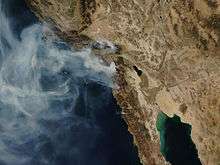2007 California wildfires
| 2007 California wildfires | |
|---|---|
|
NASA satellite photo (provided by NSPO, Taiwan National Space Organization) from October 24, 2007, showing the active fire zones and smoke plumes. | |
| Statistics[1] | |
| Total fires | 9,093 |
| Total area | 1,087,110 acres (4,399.4 km2) |
| Season | |
|
← 2006
2008 → | |
The 2007 California Wildfire Season saw over 9,000 separate wildfires that charred 1,087,110 acres (4,399.4 km2) of land.[2] 30 of those wildfires were part of the Fall 2007 California firestorm,[3] which burned approximately 970,977 acres (about 3,900 km², or 1,500 mi²) of land from Santa Barbara County to the U.S.–Mexico border, surpassing the October 2003 California wildfires in scope, which were estimated to have burned .[4] At the peak of the wildfire activity in October 2007, the raging wildfires were visible from space.[5]
The wildfires killed a total of 14 people, with nine of them dying directly from the fires;[6] 160 others were injured, including at least 124 firefighters.[7]
California Governor Arnold Schwarzenegger declared a state of emergency in seven California counties where fires were burning.[8] President George W. Bush concurred, and ordered federal aid to supplement state and local response efforts.[9] Over 6,000 firefighters worked to fight the blazes; they were aided by units of the United States Armed Forces,[10] United States National Guard,[11] almost 3,000 prisoners convicted of non-violent crimes,[12] and 60 firefighters from the Mexican cities of Tijuana and Tecate.[13] The fires forced approximately 1,000,000 people to evacuate from their homes, becoming the largest evacuation in California's history.[14]
Major contributing factors to the extreme fire conditions were drought in Southern California, hot weather, and the strong Santa Ana winds with gusts reaching 85 mph (140 km/h).[15] California's "fire season," which traditionally runs from June to October, has become a year-round threat due to a mixture of perennial drought and the increasing number of homes built in canyons and on hillsides surrounded by brush and forest.[16]
The fires had numerous sources. Several were triggered by power lines damaged by the high winds.[17] [18] One fire started when a semi-truck overturned.[19] Another was suspected as having been deliberately caused; the suspect was shot and killed in flight by state authorities.[20] A 10-year-old boy admitted that he accidentally started the Buckweed Fire by playing with matches.[21] Causes of the remaining fires remain under investigation. The last fires, the Santiago and Poomacha Fires, were fully contained on November 9, 2007, about 19 days after the series of wildfires had begun to ignite.[22]
During the season, the National Interagency Fire Center reports that two firefighters were killed. One died via helicopter and the second in a bulldozer rollover.[23]
Fires
Below is a list of all fires that exceeded 1,000 acres (4.0 km2) during the 2007 fire season.[24] The list is taken from CAL FIREs list of large fires.
| Name | County | Acres | Km2 | Start Date | Contained Date | Notes |
|---|---|---|---|---|---|---|
| 241 | Orange | 2,036 | 8.2 | 11 March 2007 | 13 March 2007 | 2 structures destroyed |
| Sierra | Riverside | 1,044 | 4.2 | 11 March 2007 | 12 March 2007 | |
| Las Flores | San Bernardino | 4,100 | 16.6 | 31 March 2007 | 1 April 2007 | 1 structure destroyed |
| Golden | Inyo | 1,988 | 8.0 | 14 April 2007 | 15 April 2007 | |
| James | Kern | 1,350 | 5.5 | 29 April 2007 | 3 May 2007 | |
| Island | Los Angeles | 4,750 | 19.2 | 10 May 2007 | 15 May 2007 | 6 structures destroyed |
| Gorman | Los Angeles | 2,050 | 8.3 | 19 May 2007 | 22 May 2007 | |
| Shannon | Tulare | 2,140 | 8.7 | 3 June 2007 | 4 June 2007 | |
| Goldledge | Tulare | 4,196 | 17.0 | 3 June 2007 | 28 June 2007 | |
| Inkopah | Imperial | 1,500 | 6.1 | 5 June 2007 | 6 June 2007 | |
| Angora | El Dorado | 3,100 | 12.5 | 24 June 2007 | 2 July 2007 | 309 structures destroyed |
| White | Kern | 12,454 | 50.4 | 24 June 2007 | 3 July 2007 | 31 structures destroyed |
| Mission | Monterey | 2,300 | 9.3 | 28 June 2007 | 28 June 2007 | |
| Zaca | Santa Barbara | 240,207 | 972.1 | 4 July 2007 | 2 September 2007 | 1 structure destroyed |
| Antelope Complex | Plumas | 22,902 | 92.7 | 5 July 2007 | 13 July 2007 | 2 structures destroyed |
| Inyo Complex | Inyo | 35,176 | 142.4 | 6 July 2007 | 16 July 2007 | 33 structures destroyed |
| Rock 2 | Tulare | 1,005 | 4.1 | 6 July 2007 | 7 July 2007 | |
| Fletcher | Modoc | 8,121 | 32.9 | 10 July 2007 | 19 July 2007 | 11 structures destroyed |
| Elk Complex | Siskiyou | 17,684 | 71.6 | 10 July 2007 | 15 September 2007 | 1 firefighter fatality |
| China-Back Complex | Siskiyou | 2,906 | 11.8 | 13 July 2007 | 21 July 2007 | |
| Bangor | Butte | 1,057 | 4.3 | 7 August 2007 | 7 August 2007 | |
| Tar | Kings | 5,644 | 22.8 | 10 August 2007 | 19 August 2007 | |
| Grouse | Tulare | 1,022 | 4.1 | 27 August 2007 | 8 September 2007 | |
| Wallow | Trinity | 1,440 | 5.8 | 29 August 2007 | 3 September 2007 | |
| North | Los Angeles | 2,200 | 8.9 | 2 September 2007 | 8 September 2007 | |
| Lick | Santa Clara | 47,760 | 193.3 | 3 September 2007 | 11 September 2007 | 24 structures destroyed |
| Moonlight | Plumas | 64,997 | 263.0 | 3 September 2007 | 15 September 2007 | 21 structures destroyed |
| Pine | San Diego | 2,170 | 8.8 | 12 September 2007 | 16 September 2007 | |
| Butler 2 | San Bernardino | 14,039 | 56.8 | 14 September 2007 | 1 October 2007 | 3 structures destroyed |
| Ranch | Los Angeles | 58,401 | 236.3 | 20 October 2007 | 30 October 2007 | 10 structures destroyed |
| Witch | San Diego | 197,990 | 801.2 | 21 October 2007 | 31 October 2007 | 1,650 structures destroyed, 2 civilian fatalities |
| Harris | San Diego | 90,440 | 366.0 | 21 October 2007 | 9 November 2007 | 472 structures destroyed, 1 civilian fatality |
| Buckweed | Los Angeles | 38,356 | 155.2 | 21 October 2007 | 26 October 2007 | 63 structures destroyed |
| Santiago | Orange | 28,400 | 114.9 | 21 October 2007 | 8 November 2007 | 24 structures destroyed |
| Canyon | Los Angeles | 4,521 | 18.3 | 21 October 2007 | 27 October 2007 | 8 structures destroyed |
| Slide | San Bernardino | 12,759 | 51.6 | 22 October 2007 | 31 October 2007 | 272 structures destroyed |
| Rice | San Diego | 9,472 | 38.3 | 22 October 2007 | 5 November 2007 | 248 structures destroyed |
| Grass Valley | San Bernardino | 1,247 | 5.0 | 22 October 2007 | 29 October 2007 | 178 structures destroyed |
| Magic | Los Angeles | 2,824 | 11.4 | 22 October 2007 | 27 October 2007 | |
| Poomacha | San Diego | 49,410 | 200.0 | 23 October 2007 | 11 November 2007 | 217 structures destroyed |
| Ammo Fire | San Diego | 21,004 | 85.0 | 23 October 2007 | 28 October 2007 | |
| Jack | Mariposa | 1,108 | 4.5 | 29 October 2007 | 15 December 2007 | |
| Corral | Los Angeles | 4,901 | 19.8 | 24 November 2007 | 27 November 2007 | 86 structures destroyed |
Counties
San Diego County
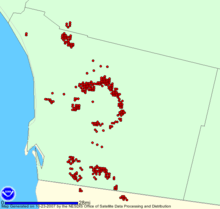
Of all the wildfires, the two largest ones were located in San Diego County. The largest, the Witch Creek Fire, burned areas in north and northeast San Diego County. The second largest, the Harris Fire, burned northwest from the U.S–Mexico border towards San Diego. Officials feared that the fires could become even more destructive than the 2003 Cedar Fire[8] that burned 280,278 acres (1,134.2 km2), destroyed 2,820 buildings (including 2,232 homes), and killed 15 people (including one firefighter) before being contained on November 3, 2003. Though individually the fires did not surpass the Cedar Fire, if combined as one, they did.[25][26]
Residents were subjected to a mix of mandatory and voluntary evacuations, depending on the projected path of a fire. Hundreds of thousands of residents were notified of evacuations via a computerized Reverse 911 phone call system. While this alert system was mostly effective, many residents in Rancho Bernardo received the calls after they had been driven from their homes.[27] On the other hand, in Carmel Valley, only the northern half was officially evacuated, but a computer error mistakenly sent Reverse 911 calls to the southern half as well. Law enforcement officers also notified residents by driving through evacuation areas. On October 24, 2007, San Diego County Sheriff Bill Kolender stated that the number of people evacuated in San Diego county had exceeded the number evacuated from New Orleans, Louisiana during Hurricane Katrina.[28]
Two days into the fires, approximately 500,000 people from at least 346,000 homes were under mandatory orders to evacuate,[29] the largest evacuation in the region's history.[30] Evacuation sites included Qualcomm Stadium,[30] as well as many schools, civic centers, and churches throughout the area.[27] The American Red Cross managed the evacuation centers.
Officials estimated that 12,000 gathered at Qualcomm. Volunteers provided food, blankets, water, internet services, children's toys, massages, and a live rock band performance for those at the stadium.[31] Nearly all public schools and universities in the San Diego area were closed. Many businesses closed as well. To ensure clear roads for emergency vehicles, San Diego mayor Jerry Sanders asked residents to stay home and inside.[32]
By October 23, some evacuations were lifted, allowing about 50,000 residents from the cities of Del Mar, Chula Vista, and Poway, and the San Diego neighborhoods of Del Mar Heights and Scripps Ranch to return home.[33][34][35] However, the fires continued and damage was severe. The four major fires across San Diego County burned nearly 300,000 acres (1,200 km2) and destroyed or damaged 1,350 homes and 100 businesses since October 21, 2007.[36]
Many major roads were closed as a result of fires and smoke. On October 22, the California Highway Patrol closed Interstate 15 in both directions between State Routes 78 and 56.[27] On October 24, 2007 the Horno Fire forced the closure of Interstate 5 as well as the Amtrak Surfliner service between Oceanside and San Clemente.[37] Traffic from Interstate 5 was diverted to Interstate 15, which had reopened.[38]
Officials from the San Diego Wild Animal Park said that its more than 3,500 animals were safe staying in their enclosures where they were protected by the park's fire break and irrigated areas. If the weather conditions worsened, the animals could retreat to their watering holes. However, many critically endangered animals such as the California condor were moved to the park's veterinary hospital, which is fire-resistant and fully equipped with sprinklers. Park spokesperson Yadira Galindo said that the animals were "alert but not showing any concerned behavior."
Other fires
- Marine Corps Base Camp Pendleton Fires:
- The Wilcox Fire began at Santa Margarita/33 Area behind Marine Corps Air Station Camp Pendleton.[39][40]
- The Ammo Fire was located near the Las Pulgas/43 Area and Basilone Road.[39][41]
- The Horno Fire burned 21,084 acres (85 km2), and was located in the Basilone Road and Canyon Road/Las Flores/41 Area.[22][37][38][39][42]
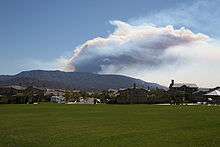
- The Poomacha Fire (or Mt. Palomar Fire) began as a structure fire on the La Jolla Indian Reservation, then established itself on Palomar Mountain, joined the Witch Fire, and entered the Agua Tibia Wilderness. Because of steep terrain, it continued to burn after all other October 2007 fires were put out, finally reaching full containment November 9, 2007.[22]
- The Coronado Hills Fire started near San Marcos, and burned south of Cal State San Marcos.[41]
- On October 23, the San Diego Union Tribune reported on the El Capitan Fire: "A small brush fire that burned today around El Capitan Reservoir north of Alpine is out, Cal Fire officials said about 9:30 p.m. Officials said the blaze consumed the vegetation near the reservoir and ran out of fuel."[43]
- The McCoy Fire started on the Cleveland National Forest near the intersection of the Eagle Peak and Boulder Creek roads west of Rancho Cuyamaca State Park. It burned 400 acres (1.6 km2) and destroyed at least one structure in Pine Hills.[44]
Los Angeles and Ventura counties
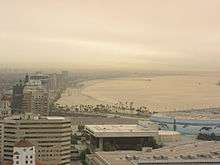
Numerous fires burned in Los Angeles and Ventura Counties.
- The Buckweed Fire burned north of Santa Clarita in Agua Dulce and the community of Canyon Country, triggering many evacuations.[45] This fire was the result of a child playing with matches.[21]
- The Canyon Fire burned around Malibu, California, specifically in Malibu Canyon. It was the first of the October 2007 California wildfires to receive significant attention from the national media.[46] In addition to damaging or destroying 14 homes, the fire destroyed two Malibu landmarks: Castle Kashan and the Presbyterian Church.
- The Magic Fire started near The Old Road at Magic Mountain Parkway, within a half mile of the Six Flags Magic Mountain theme park on the west side of Santa Clarita. Flames came within a few yards of West Ranch High School and a large housing development in Stevenson Ranch, but were pushed away. The fire is believed to have been caused accidentally by welders at a construction site.[41]
- The Meadowridge Fire began near Highway 14 and San Fernando Road, just North of Granada Hills.[41]
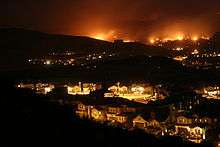
- The October Fire burned a small area in Santa Clarita, destroying several homes in the Canyon Breeze Mobile Home Park.[41]
- The Ranch Fire (or Castaic Fire) burned along the Los Angeles-Ventura county line about 5 miles (8.0 km) north of Santa Clarita,[41] in the Angeles and Los Padres national forests. It surrounded the Ventura County community of Piru[46][47] and also threatened the communities of Fillmore, Ventura and Ojai.[41] About 500 residences lie in the fire's path.[41] Evacuations were recommended in all of Piru and portions of Fillmore.[47] Angeles National Forest officials implemented a total forest closure on October 23.
- The Nightsky Fire burned a small area south of Moorpark in Ventura County.[41]

San Bernardino County
- The Slide or Green Valley Lake Fire burned near Green Valley Lake, east of Lake Arrowhead. The Green Valley Lake, Arrowbear, and Running Springs communities were evacuated. 1,359 firefighters were assigned to the fire. The estimated cost is $1.2 million. Water pressure in local systems was lost and conditions were too extreme for fighters to continue efforts in some areas.[41] The fire partially burned "Camp Helendade," owned by the Boy Scouts of America's local council, the California Inland Empire Council. Helendade was originally given to the council in 1960 to replace another camp that had been burned.[48][49][50]
Riverside County
- The Roca Fire was reported around 3:52 p.m. on October 21 in the vicinity of SR 79 at SR 371 in Aguanga. One home was destroyed and one injury was reported. It was 100% contained on October 22, after burning 270 acres (1.1 km2).[41]
- The Rosa Fire, three clustered blazes in the Via Santa Rosa/Rancho California Road area of western Temecula began October 22. It was 100% contained by October 24, after burning 411 acres (1.7 km2). Investigators suspect arson.[51]
- The Wildomar Fire began around 12:30 on October 24 in Wildomar brush, between I-15 and I-215. It was 100% contained within the same day, after burning 20 acres (0.1 km2).[52]
Baja California
Fires also burned in northern parts of the Mexican state of Baja California.[53] The Harris Fire burned near Tecate,[54][55] and fires burned near Tijuana as well.[56]
More than fifteen thousands hectares were consumed by the wildfires in Baja California. Tijuana, Tecate and Ensenada were the municipalities more affected by the fire. In total there were seven fires caused by Santa Ana winds. The community of Maneadero, in the highlands of Ensenada, was the most affected.[57]
Wind and weather

The fires occurred at the end of a dry summer and were exacerbated by the seasonal Santa Ana winds. The San Diego Union Tribune reported, "Santa Ana winds blowing up to 60 mph (97 km/h) combined with temperatures into the 90s to create in the worst possible fire conditions."[58] At one point swirling winds threatened to bring fire into densely populated urban areas.[16]
Southern California was in the midst of an unusual drought; in Los Angeles, with only 3.21 in (82 mm) of precipitation in 2006–2007, it was the driest year on record.[59] The combination of wind, heat, and dryness turned the chaparral into fire fuel. Officials believed that some of the fires generated their own winds, similar to the Oakland Firestorm of 1991. The effects of the smoke were felt as far away as Brentwood, California (in the East Bay, near Stockton), where it impacted local weather. The high-speed Santa Ana winds also rendered the use of dropping water from fire fighting aircraft inefficient; until such winds abate, most payloads of water are just dispersed by the wind over an area so large that the water evaporates before it can reach a large fire on the ground.
Impact

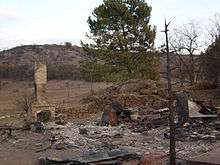
On October 21, the Harris Fire damaged and disabled the Southwest Power Link, a 500,000-volt power line from Arizona to San Diego.[60] Power outages were reported in Los Angeles, Orange, San Diego, and other counties on October 22 to 333,500 Southern California Edison customers, most being restored within 24 hours. The power outage also affected the areas of Ojai, Oxnard, Simi Valley, Santa Clarita, Thousand Oaks, Agoura Hills, Rialto, Fontana, San Bernardino, Rancho Cucamonga, Mira Loma, Hesperia, Corona, Bloomington, Irvine, Calimesa and Rubidoux. This outage also caused 230 people to be without power in Malibu.[61] The California Independent System Operator Corp declared an energy transmission emergency in southern California on October 23, due to wildfires affecting the lines. 500,000-, 230,000- and 138,000-volt lines were disabled in San Diego, and some lines in other areas were also disabled. 24,992 people lost power, due to the lack of power from the power grid.[60] During the crisis, Mexico provided power to help augment the electrical needs of the San Diego area.[62]
Authorities have stated that the evacuations, which displaced more than 900,000 people, have been the largest evacuation number in the history of California.[63] By mid-morning on October 22, 2007, thousands of evacuees were taking shelter in Qualcomm Stadium and other locations throughout San Diego.[30] On the afternoon of October 22, 2007, the Marines evacuated some planes from Marine Corps Air Station Miramar to other military bases in California and Arizona.[64] The Navy moved all non-essential personnel from Naval Base San Diego barracks onto nearby vessels to accommodate refugees.[11] The San Diego Wild Animal Park moved some animals to the on-site animal hospital for their protection.[27]
The Horno Fire had charred 6,000 acres (24 km2) in Camp Pendleton by 4:00 A.M PDT, on October 24, 2007. It caused the closure of Interstate 5 and it also caused Amtrak to stop Surfliner service between Oceanside and San Clemente.[37] Traffic was being diverted to Interstate 15, which had itself been closed earlier.[38] Illegal migrant workers were endangered by the crisis, sometimes staying at work in the fields within mandatory evacuation zones. Many had lived in the canyons nearby and distrusted officials.[65] When fleeing the fires, some were arrested, while others were turned away from shelters due to lack of adequate identification.[66] Some Mexican firefighters expressed concern about their countrymen, while others felt the migrant workers were aware of the risks they were taking.[67]
Only a few cases of looting were documented. Six people were arrested for stealing supplies from Qualcomm stadium,[68] another was arrested for theft after being found in possession of stolen goods in the Jamul fire area,[69] and two were arrested near the Tecate border crossing.[70]
Air quality and effects on health
The concentration of particulate matter 10 micrometers and smaller (designated PM10) reached unhealthy levels as a result of the fires. PM10 particles are small enough to enter deep into the lungs, and possibly the bloodstream. San Diego city attorney Michael Aguirre, citing concerns over weather conditions and air quality, urged the city to consider a voluntary evacuation of the entire city.[71]

Response
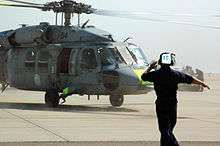
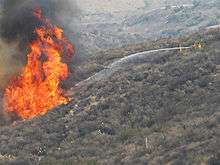
Government agencies and volunteers worked together to mitigate the effects of the fires. According to the state of California's Consolidated Response web page, "There are 17 active fires in Southern California. The priority for fighting fires as of 19:30 on October 21 is the Buckweed, Witch, Harris, Canyon, Ranch, Santiago, and Sedgewick Fires."[72] March Air Reserve Base is the primary staging area for relief supplies as coordinated by the Federal Emergency Management Agency.[11]
With many businesses and schools closed, some people used their time off to help others. Officials estimated that 10,000 people were gathered at Qualcomm Stadium, the largest shelter point in San Diego. Besides food, blankets and water, volunteers provided toys for children, massages, and a live rock and roll band performance.[31] CERT teams, in various cities, received their first activation since the program's inception in this region. Trained volunteers provided assistance ranging from coordinating relief, to acting as a fire department auxiliary.[73][74] Religious groups such as Victim Relief Ministries, Giving Children Hope, Hope Force International, Apostolic World Relief, and the Salvation Army responded by opening places of worship, donating supplies, and feeding workers and evacuees.[75][76]
The Department of Defense contributed twelve engines for firefighting efforts. The National Guard called more than 2,400 troops,[77] with 17,000 available if needed; of which 100 California National Guard medical personnel provided medical assistance.[11] Six crews from the Navy's Helicopter Sea Combat Squadron 85 based at Naval Air Station North Island were assigned to battle the Witch Creek fire. They flew MH-60 Seahawk helicopters equipped with a 420-gallon water bucket and they were the only local Navy teams trained to fight fires from the air. Marine Corps Air Station Miramar contributed several aircraft as well as fire fighting trucks to operations based in Ramona.[10] One of the larger airtankers, the Martin Mars, sent through a private contract from its home in Port Alberni, British Columbia on October 25, landing on Lake Elsinore in Riverside County, California. It has a 7,000 gallon capacity. Two other airtankers and their crews from Quebec worked on the fires, part of an annual three-month contract with the state of California.[78]
California Governor Arnold Schwarzenegger declared a state of emergency in seven California counties where fires burned. President George W. Bush concurred[9] and visited the region on Thursday, October 25, 2007.[36][79]
Rep. Duncan Hunter criticized state fire officials for delaying the use of Marine helicopters until CalFire spotters were in position to coordinate their efforts. However, California Fire Marshal Kate Dargan said that the Marines and officials at CalFire were following procedures worked out with the military after serious problems with air coordination during the 2003 California wildfires. Other state officials also praised the federal response. Aaron McLear, a spokesman for Schwarzenegger, said the governor "is getting everything he needs from the federal government".[80]
NBC Nightly News reported that with the evacuations reaching about 950,000 people, this was the largest peacetime movement of Americans since the Civil War era,[81] although similar evacuation figures were cited for Hurricane Rita[82] and Hurricane Katrina.[83]

On November 6, 2007, the state of California reported that the fires were under control. On November 9, the last vole of wildfires were finally contained. According to the state's consolidated report on the fires, Governor Arnold Schwarzenegger "called on the Blue Ribbon Task Force to assess the next steps to take at federal, state and local levels of government to prevent and fight future fires. Additionally, the Governor asked the task force to review the Governor’s Blue Ribbon Fire Commission’s recommendations, generated after the 2003 fires, to evaluate if the recommendations are still the best and most effective ways in preventing and fighting fires."[84]
See also
- November 2007 California wildfires
- List of California wildfires
- Wildfires in California-related topics
- FIRESCOPE
References
- ↑ "National Report of Wildland Fires and Acres Burned by State 2007" (PDF). National Interagency Fire Center. Retrieved 2 October 2015.
- ↑ "National Report of Wildland Fires and Acres Burned by State 2007" (PDF). National Interagency Fire Center. Retrieved 21 August 2015.
- ↑ "California Fire Siege 2007 : An Overview" (PDF). Fire.ca.gov. Retrieved 2016-05-19.
- ↑ "Archived Fires". Cdfdata/fire.ca.gov. Retrieved 2016-05-19.
- ↑ "California Fires Rage, Visible in Space". National Geographic. 2007-10-23. Retrieved 2009-05-04.
- ↑ "Firestorm Claims 9th Victim". NBCSandiego.com. KNSD. November 8, 2007. Archived from the original on 2007-12-02. Retrieved 2007-11-09.
- ↑ "Fire deaths, damage come into focus as evacuees cope". cnn.com. CNN. October 26, 2007. Retrieved 2007-10-28.
- 1 2 Archibold, Randal C. (2007-10-23). "Residents Flee Wildfires in S. California". New York Times. Retrieved 2007-10-23.
- 1 2 "Statement on Federal Disaster Assistance for California" (Press release). The White House. 2007-10-23. Retrieved 2007-10-24.
- 1 2 3 4 "Military helps fight fires while personnel evacuated". CNN.com. October 23, 2007. Retrieved 2007-10-23.
- ↑ "California turns to prisoners to fight huge fires". reuters.com. Reuters News Service. October 26, 2007. Retrieved 2007-10-28.
- ↑ "Mexican firefighters helping in California return to Mexico to fight blaze". signonsandiego.com. San Diego Union Tribune. October 23, 2007. Retrieved 2007-10-28.
- ↑ McLean, Demian; Peter J. Brennan (October 24, 2007). "California Fires Rout Almost 1 Million People, Kill 5 (Update7)". Bloomberg.
- ↑ Chang, Alicia (2007-10-22). "Southern California wildfires blamed on unusual Santa Ana winds". KOLO-TV. Archived from the original on 2014-06-12. Retrieved 2014-06-12.
- 1 2 Adams, Guy (2008-11-17). "50,000 flee homes as fires rage in California". The Independent. London. Retrieved 2009-05-06.
- ↑ "Firefighters Protect Homes In Foothill Ranch". KNBC. 2007-10-22. Retrieved 2007-10-22.
- ↑ "Power lines cited as cause of largest wildfires". SAN DIEGO UNION-TRIBUNE. 2007-11-16. Retrieved 2007-11-16.
- ↑ Stephen Wall; Gina Tenorio; Jannise Johnson. "Fontana homes evacuated, freeways closed". DailyBulletin.com. Retrieved 2007-10-24.
- ↑ Attewill, Fred (October 25, 2007). "California police shoot dead suspected arsonist". Guardian. London. Retrieved 2007-10-27.
- 1 2 Daisy Nguyen (2007-10-30). "Boy with matches started fire that burned 21 homes". Long Beach Press-Telegram. Retrieved 2007-10-31.
- 1 2 3 "Late October, 2007 California Wildfire Web Pages". FIRESCOPE: FIrefighting RESources of California Organized for Potential Emergencies. 2007-11-09. Retrieved 2007-11-10.
- ↑ "Wildland Fire Accidents and Fatalities by Year" (PDF). National Interagency Fire Center. Retrieved 28 August 2015.
- ↑ "Large Fires 2007" (PDF). CAL FIRE. Retrieved 21 August 2015.
- ↑ "Cedar Fire & Memorial". Lakeside Historical Society. Retrieved 2007-10-27.
- ↑ Cedar Fire-Final Update, State of California website. Note, some references, such as Esri report the acreage of the Cedar Fire at 273,246 acres; however, this article uses the figure reported by the State of California.
- 1 2 3 4 Martinez, Angelica; Greg Gros (October 22, 2007). "Witch fire roars west across Rancho Bernardo and Poway". SignOnSanDiego.com. San Diego Union Tribune. Retrieved 2007-10-22.
- ↑ "Fire evac surpasses Katrina". SignOnSanDiego.com. San Diego Union Tribune. October 24, 2007. Retrieved 2007-10-24.
- ↑ "California Wildfires Trigger Widespread Evacuations". NPR (2007-10-24). Retrieved on 2007-10-24.
- 1 2 3 H.G. Reza; Jill Leovy; Alex Pham (October 24, 2007). "Scale of the fires' disruption on display at San Diego stadium". LA Times. Retrieved 2007-10-24.
- 1 2 "Surveyor makes order out of chaos for evacuees". SignOnSanDiego.com. San Diego Union Tribune. October 22, 2007. Retrieved 2007-10-22.
- ↑ William M. Welch; Patrick O'Driscoll; Chris Woodyard (2007-10-23). ""Staggering" numbers flee amid fear and uncertainty". USA Today. Retrieved 2007-10-24.
- ↑ "Evacuation orders lifted for some San Diego neighborhoods". The Associated Press published on San Jose Mercury News (2007-10-12). Retrieved on 2007-10-12.
- ↑ "Evacuees Allowed To Return To Del Mar, Chula Vista, Scripps Ranch and Poway". NBC San Diego. Retrieved on 2007-10-23.
- ↑ "Some Evacuees Return Home". KGTV 10 News (2007-10-24). Retrieved on 2007-10-24.
- 1 2 "Fire damage severe, but worst may be over". sandiegouniontribune.com. San Diego Union Tribune. October 23, 2007. Retrieved 2007-10-23.
- 1 2 3 "Camp Pendleton fire spread to 6,000 acres (24 km2)". SignOnSanDiego.com. San Diego Union Tribune. October 24, 2007. Retrieved 2007-10-24.
- 1 2 3 "Traffic diverting to north I-15". SignOnSanDiego.com. San Diego Union Tribune. October 24, 2007. Retrieved 2007-10-24.
- 1 2 3 "Southern California Wildfires Camp Pendleton Information Hotline (866) 430-2764". 2007-10-26. Retrieved 2007-10-26.
- ↑ "Flames on Pendleton". SignOnSanDiego.com. San Diego Union Tribune. October 23, 2007. Retrieved 2007-10-23.
- 1 2 3 4 5 6 7 8 9 10 11 "Cal Fire". October 23, 2007. Retrieved 2007-10-23.
- ↑ "Southbound I-5 open at Pendleton". SignOnSanDiego.com. San Diego Union Tribune. October 24, 2007. Retrieved 2007-10-24.
- ↑ Repard, Pauline (October 23, 2007). "El Capitan fire out". SignOnSanDiego.com. San Diego Union Tribune. Retrieved 2007-10-23.
- ↑ "Fire Crews Surround McCoy Fire". 10news.com. October 23, 2007. Retrieved 25 August 2016.
- ↑ Jason Song; Jean-Paul Renaud; Scott Gold; Molly Hennessy-Fiske (October 22, 2007). "Buckweed fire becomes top priority". Los Angeles Times. Retrieved 2007-10-27.
- 1 2 "South San Diego County fire kills 1, injures 17". October 22, 2007. Retrieved 2007-10-22.
- 1 2 "Ranch Fire surrounds Piru, Nightsky Fire contained, small blazes doused". Ventura County Star. October 22, 2007. Archived from the original on 2008-12-02. Retrieved 2007-10-22.
- ↑ "Running Springs Fire Update". California Inland Empire Council. Retrieved 2007-10-23.
- ↑ "Fires Consume 5,000 acres (20 km2) Total". Fire & Wind. The Sun Daily Bulletin. October 24, 2007. Retrieved 2007-10-23.
- ↑ "Camp Helendade Website - Boy Scouts of America". Camp Helendade Website. Retrieved 2007-10-23.
- ↑ "Officials: 22,000-acre (89 km2) fire was set". cnn.com. October 25, 2007. Retrieved 2007-10-25.
- ↑ "Fire Crews Eye Riverside County's Southern Border". cbs2.com. October 25, 2007. Archived from the original on 2007-10-27. Retrieved 2007-10-25.
- ↑ Ford, Dana (24 October 2007). "Incendios en California dejan al menos cinco muertos" (in Spanish). Reuters. Retrieved 2007-10-24.
- ↑ "KPBS Google Map". Google.com. October 24, 2007. Retrieved 2007-10-24.
- ↑ "Las llamas logran cruzar la frontera" [Flames manage to cross the border] (in Spanish). Diario de Yucatán. 24 October 2007. Retrieved 2007-10-24.
- ↑ Durán, Laura (22 October 2007). "Cierran tramo de carretera Tijuana-Tecate por incendio" (in Spanish). La Frontera. Retrieved 2007-10-24.
- ↑ Hernandez, Jorge (25 October 2007). "Incendios forestales arrasan 15 hectareas en BC" (in Spanish). Noticieros Televisa. Retrieved 2007-11-12.
- ↑ McDonald, Jeff and Janine Zuniga and Kristina Davis (October 22, 2007). "County asks for 1,000 more firefighters". SignOnSanDiego.com. San Diego Union Tribune. Retrieved 2007-10-22.
- ↑ Kahn, Carrie (July 6, 2007). "NPR: Water Flows in Los Angeles Despite Drought". Retrieved 2007-10-24.
- 1 2 "Fires wreak havoc on region's electricity supply". Jeran Wittenstein. San Diego Daily Transcript. October 23, 2007. Retrieved 2007-10-26.
- ↑ "SoCal Crews Respond To 'Fire After Fire'". KNBC. KNBC.com. October 22, 2007. Retrieved 2007-10-22.
- ↑ "From far and wide, helpers pour into a fire-stricken San Diego". scmonitor.com. The Christian Science Monitor. October 26, 2007. Retrieved 2007-10-28.
- ↑ Reza, H.G.; Leovy, Jill; Pham, Alex (October 23, 2007). "Scale of the fires' disruption on display at San Diego stadium". LATimes.com. Los Angeles Times. Retrieved 2007-10-23.
- ↑ "Miramar evacuating some aircraft". SignOnSanDiego.com. San Diego Union Tribune. October 22, 2007. Retrieved 2007-10-22.
- ↑ Amy Isackson (October 25, 2007). "Fires Highlight Safety Needs of Migrant Workers". npr.org. National Public Radio. Retrieved 2007-10-28.
- ↑ "Immigrants Step Out of the Smoke". kcbs.com. KCBS All News Radio 740 AM. October 27, 2007. Retrieved 2007-10-28.
- ↑ Ari B. Bloomekatz (October 27, 2007). "Mexican fire crew joins the fight". latimes.org. Los Angeles Times. Retrieved 2007-10-28.
- ↑ "Illegal immigrants suspected of stealing supplies". SignOnSanDiego.com. San Diego Union Tribune. October 24, 2007. Retrieved 2007-10-24.
- ↑ "Another looting arrest". SignOnSanDiego.com. San Diego Union Tribune. October 24, 2007. Retrieved 2007-10-24.
- ↑ "Two looting arrests in Tecate". SignOnSanDiego.com. San Diego Union Tribune. October 24, 2007. Retrieved 2007-10-24.
- ↑ Vigil, Jennifer (October 24, 2007). "Aguirre wants San Diego evacuated in wake of wildfires". SignOnSanDiego.com. San Diego Union Tribune. Retrieved 2007-10-24.
- ↑ "Southern California Fire Report". CalFires.com. State of California. October 22, 2007. Retrieved 2007-10-22.
- ↑ Kelly Strodl (October 25, 2007). "Daily Pilot". Daily Pilot. Retrieved 2014-02-07.
- ↑ "Emergency volunteers' debut lauded". Metro News. San Diego Union Tribune. 2007-11-26. Retrieved 2009-05-12.
- ↑ "Faith community reaches out to fire victims". The Kansas City Star. 26 October 2007. Retrieved 2007-10-28.
- ↑ "Religious Group Offers Gentle Comfort to Wildfire Victims". foxnews.com. Fox Network. 28 October 2007. Retrieved 2007-10-28.
- ↑ LTC Jon Seipmann (2007-10-25). "Press Release 10-17". California National Guard. State of California. Retrieved 2009-05-12.
- ↑ "Privately owned B.C. water bomber flying to fight California fires". cbc.ca. CBC News. October 23, 2007. Archived from the original on 2014-06-12. Retrieved 2014-06-12.
- ↑ "Bush promises aid for victims of California fires". Associated Press. October 23, 2007. Retrieved 2007-10-23.
- ↑ "Did the state delay Marine copters?". SignOnSanDiego.com. San Diego Union Tribune. October 23, 2007. Retrieved 2007-10-23.
- ↑ "USNews.com Political Bulletin". US News and World Report. 2007-10-24. Retrieved 2007-10-24.
- ↑ "Hurricane Rita Information". Texas Online. State of Texas. Retrieved 2007-10-24.
- ↑ "New Orleans braces for monster hurricane". CNN. August 29, 2005.
- ↑ "Governor Calls on Blue Ribbon Task Force to Review State Fire Response". State of California. November 6, 2007. Retrieved 2007-11-06.
External links
| Wikimedia Commons has media related to California wildfires of October 2007. |
| Wikinews has related news: Wildfires burn in southern California |
Maps
- CalFire map
- LA Times managed Google map showing fire locations and relevant information
- MSNBC managed Virtual Earth map showing fire locations
- KPBS managed Google map with detailed San Diego area information
- San Diego County map showing evacuated areas
- CBS 8: San Diego fire maps
- Orange County Register detailed map of Santiago fire
Academics and research
- MAP.SDSU.EDU - mapping, database and geographic information system for the 2003 and 2007 fires, managed by the San Diego GIS force group, and hosted by San Diego State University
- The San Diego Fire Recovery Network - a Southern California organization which addresses the widespread ecosystem changes in San Diego County caused by the 2003 and 2007 wild fires
- The GIS Data Center for San Diego Fire Recovery Network - hosted by San Diego State University
- Let Malibu Burn: A political history of the Fire Coast by Mike Davis
- 2007 Southern California Wildfires Web Archive at the California Digital Library.
